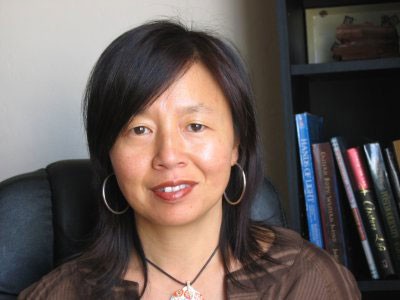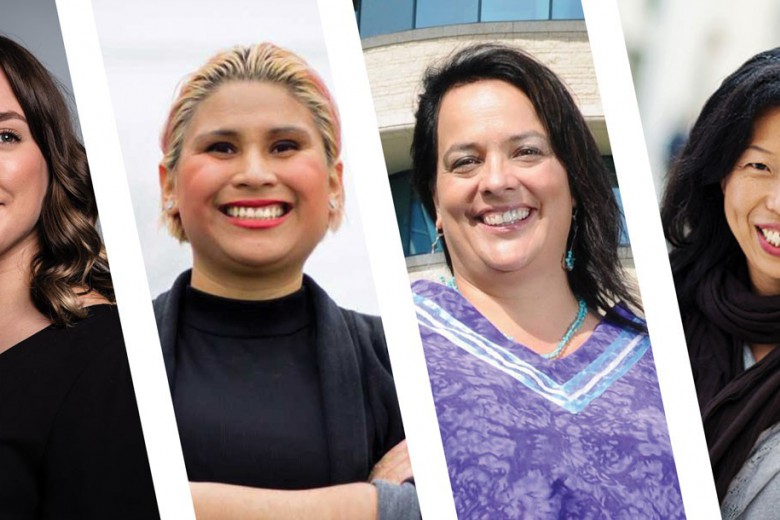
Mimi Kim is a second-generation Korean American and long-time organizer against domestic and sexual violence, racism and imperialism. Her pragmatic approach to defending the safety and integrity of women stems from years of work on the ground with women of colour and others who have been marginalized from the mainstream anti-violence movement.
After a decade working at the Asian Women’s Shelter in San Francisco in the 1990s, Kim founded several subsequent initiatives. She is the co-founder of Shimtuh: Korean Domestic Violence Program and a founding member of INCITE! Women of Color Against Violence. She also currently serves on the national steering committee of the Asian & Pacific Islander Institute on Domestic Violence.
Kim’s latest project, Creative Interventions, was born out of a frustration with the limited options available to people seeking solutions to violence. Based on a belief in the need for collective, rather than individual responses to violence, Creative Interventions seeks to address violence proactively within the spaces in which it occurs. Through education and dialogue between survivors, abusers and their communities, the project opens new possibilities for once abusive individuals and communities to evolve together toward healthier relationships.
Valerie Zink caught up with Kim to learn more about her perspective on the relationship between interpersonal and state violence, the criminal justice system, and community accountability.
Can you explain the concept of community accountability in relation to interpersonal violence, and where this idea originated?
Community accountability can be defined as an approach to interpersonal violence that recognizes that communities, and not just individuals, are affected by violence – and that communities have a central role in addressing and ending violence.
Survivors and their communities – their friends, family, children, neighbours, co-workers, members of organizations, and also people doing harm – are the people who have the most intimate knowledge of the context in which violence is occurring, of what might keep people safest, and what might influence someone to stop.
These forms of knowledge have not been recognized by the anti-violence movement and have not been supported as a valuable resource in stopping violence. This alienation of people from their own knowledge is part of how capitalism works. The idea that only professional experts, police, prosecutors and so on can stop violence, and that they are the authorities to define who are the individual perpetrators, aligns perfectly with the criminalization agenda and the defining of certain people as dangerous perpetrators to be “held accountable” by the state, and others as victims to be “protected” by the state.
What is the relationship between state violence, in the form of incarceration, detention and deportation, child apprehension, police brutality, etc., and interpersonal violence? How do we address these forms of violence concurrently in our movements?
We have to have an intersectional analysis that looks at interpersonal violence as being tied to state violence. I don’t take the position that there’s a one-to-one causal linkage between capitalism and gender-based violence – they are interrelated, but I don’t think that an end to capitalism necessarily means an end to patriarchy. Gendered violence predates capitalism.
That being said, the vulnerability of people to interpersonal violence is heightened by the violence of poverty and the inability of people to provide for the material survival of themselves and their families. Women stay in violent relationships because they have no other form of survival. There are so many ways that the state devalues people based on their gender, race, immigration status, sexuality, ability – and supports the material deprivation of these same people through the extortion of the market. This creates a context in which people are vulnerable to violence of all kinds, including interpersonal violence.
Within the mainstream anti-violence movement there has been a complete separation of these forms of violence – there is an individualizing of interpersonal violence, and often an analysis that only looks at gender, and only at a gender binary. What some of us are trying to do is to be more complex about the way we look at gender, race, class, sexuality, ability and so on.
Where does the mainstream anti-violence movement’s reliance on the criminal justice system – itself an institution of violence, domination and control – stem from?
Right now I’m looking into the origins of the contemporary anti-violence movement in the 1970s. I think there’s this idea that it had more radical roots, which I believe is true, but it also turned quite quickly – or at least some aspects of it – to a focus on the criminal justice system. I think this probably started out as an attack against the police, who were not taking violence against women seriously. But what it turned out to be, and quite early on, was a collaboration between the anti-violence movement and the criminal justice system.
There was a pretty immediate deradicalization of the movement at that point. It silenced the responses of huge portions of the feminist movement who would have otherwise been mounting pressure against, and had a critical response to, criminalization.
A report from Statistics Canada released earlier this year indicates that only 22 per cent of domestic violence occurrences are reported to the police, a figure that has been declining steadily over the past decade. Why are women increasingly choosing not to go to the police in these situations?
Having worked a lot with immigrant communities, I can say that for many women it would be very unwise to go to the criminal justice system, particularly if they are undocumented. There was a time when there was some degree of separation between the police and immigration, but that’s not true anymore.
You have people who may be seeking safety, but they know that contacting the police may result in deportation or detention, not only of themselves, but of a partner, or whomever – somebody who’s causing harm, but not necessarily somebody that they want to end up incarcerated, or possibly deported.
There are more and more classes of people who are under attack by the state, and it has become clear to many people that calling the police will bring harm against themselves – not only in immigrant communities, but also in queer and transgender communities, in which there has been an enormous amount of police brutality. I also know that a lot of women experiencing domestic violence and sexual assault have themselves been criminalized as a result of mandatory arrest policies, in which the person seeking safety is often the person who is actually arrested.
How do you define community in the context of community accountability? Is there a risk of fostering a romanticized notion of communities, which have not for the most part demonstrated a serious commitment to addressing sexism, homophobia and interpersonal violence, or a capacity to respond to violence effectively? Given that people are to varying degrees isolated from meaningful community connections, can we assume that community accountability is an option for everyone?
I definitely think that we can romanticize community. I also think that for those who are on the ground working on this, at least the ones I know, their romance ends pretty quickly.
On the one hand, a large part of the anti-violence movement doesn’t really think that community is capable of anything. But I also think that we’re going to figure out what community means as we do this work on the ground. Through Creative Interventions, people are asked who they think their community is in that moment – who are the people they can rely on? That sounds very abstract, but when you’re facing a very concrete situation of interpersonal violence, it’s no longer abstract. It becomes “okay, can I count on my workplace, can I count on my organizations, my family and friends? Am I connected with more of an identity-based community that might not even just be local, it might be across state lines, across national lines?” and so on.
What does community accountability and collective action against sexual violence look like in practice? What strategies have you found effective, both in responding to interpersonal violence, and also addressing the root causes of violence?
Creative Interventions is one among many organizations that have been trying to come up with answers on the ground to practical, as well as political questions. One of the first things we do is to take as a starting point whomever it is who is looking to intervene in violence. This is a departure from the mainstream anti-violence movement, which always starts with the individual survivor. What we are doing differently, right from the start, is breaking away from the idea that this is solely about an isolated victim or survivor of violence. An intervention might begin with a survivor, but it might also begin with the person doing harm, or it might be friends and family.
Part of community accountability is recognizing that we are all affected by interpersonal violence, some of us more directly than others, and we all also have a role to play in changing the conditions that support violence.
What does accountability mean in practice? What is it exactly that we are demanding of, and expecting from, a person who has caused harm?
That is a question that we raise constantly, in part because we have discovered how much we are bound to, and tied by, the kinds of notions of justice that we’ve been socialized with. Even though we use the word accountability, we know how much it still gets tied in with the idea of punishment. That’s something we are constantly trying to break down, and we don’t have the vocabulary that fits it.
What we are trying to move away from is the idea that accountability means putting somebody up against the wall, and using punishment and force to get someone to admit what they did and take responsibility. At the same time, we don’t want to avoid force entirely, or avoid using any kind of authority.
It’s been a struggle, and that’s why we’ve had to reach out across different community organizations and ask “how did you do this in a way that didn’t reproduce punishment, and didn’t reproduce collusion?” I wish I could give you the answer right now. We’re still raising these questions.
Accountability involves acceptance, not only on the part of the individual who did harm, but also by the community. An acceptance of the consequences of attitudes and actions that one might not have been aware of, and the humility to listen to another person’s perspective that you may not have held… these are all components of what we think accountability is.
What is the role of survivors in community accountability processes?
That’s another thing that we are in a bit of a grey area to define. Whereas the anti-violence movement claims to be survivor-centred (although I would argue against that), Creative Interventions has explicitly said that we are not survivor-centred. I know that makes a lot of people uncomfortable. That’s not to say there is not a specific and special consideration to be made of the survivors’ perspectives and experiences, their knowledge about what happened, and their perspectives regarding how to proceed.
In some situations that may mean that there’s a survivor-defined process, but we also wanted to step back from that and say that that may not always be the case. There may be situations in which other community members would be more at the centre of a response to violence, and there may be a stage at which it becomes more of a collective experience.
What we are asking ourselves is, how can it be an overall liberatory experience for everybody? What do we do when that is sometimes at odds with what the survivor wants? We have to get better at dealing with these complexities.
For more information about Creative Interventions, visit www.creative-interventions.org



_780_520_90_s_c1.jpg)


